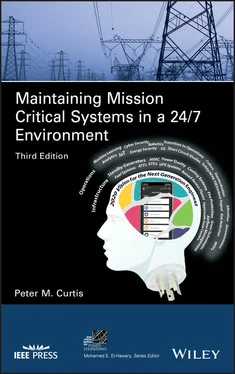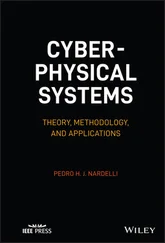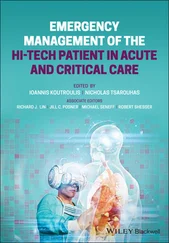Specifically, CEIDS focuses on three reliability goals:
1 Preparing high‐voltage transmission networks for the increased capacity and enhanced reliability needed to support a stable wholesale power market.
2 Determining how distribution systems can best integrate low‐cost power from the transmission system with an increasing number of distributed generation and storage options.
3 Analyzing ways to provide digital equipment, such as computers and network interfaces, with an appropriate level of built‐in protection.
It is only through these wide‐reaching efforts to involve all industry constituencies that the industry can raise the bar with respect to protective measures and knowledge sharing.
2.5 Use of Distributed Energy Resources and Generation
The way electricity was produced before the advent of our modern electric grid has received renewed interest over the past couple of decades. Unlike the large centralized power plants located at the top tier of our electric grid, much smaller distributed generation (DG) systems are now being deployed at the bottom tier, typically installed on‐site by the end electric user. This trend is spurred on by growing concern over our aging electric infrastructure, widespread outages like what occurred in 2003, customer desire to have an alternative to their grid electric supply, and environmental impact. Some new technologies, such as fuel cells and microturbines that have much lower emissions than fossil‐fuel central power plants, are being used on‐site for a wide variety of applications. Other “green” renewable technologies, including solar and wind, are also becoming more widely applied as distributed resources (DR). They are helped financially by an assortment of federal, state, and utility incentives that provide various grants, rebates or tax benefits to help justify the installation. Some generalizations that favor DG include:
1 Since most DG is of relatively small scale, it is more modular and can be sized to match a facility’s base load, sized to just supplement the grid supply, or in cogeneration applications, sized to just meet the thermal requirements.
2 In general, DG is a cleaner alternative to grid electricity. Solar and wind power produce no emissions and completely offset the emissions and greenhouse gas production of central power plants.
3 Even with fossil fuel‐based DG, if waste heat recovery offsets the use of some separate fuel combustion for thermal needs, a net reduction in greenhouse gas emissions can be realized.
4 Many DG systems are designed to run grid‐parallel, and only operate when the grid supply is available, such as systems that employ induction generators or line commutated inverters. DG systems that use synchronous generators or self‐commutated inverters can also be designed to run grid‐independent to provide standby power.
5 Of the various DG benefits, some may be less tangible than others, but in general, most DG is installed with the objective of reducing the owner’s energy costs while also providing an acceptable rate of return on the capital investment. For cogeneration systems, it’s the ‘spark spread’ – the difference in cost between the DG fuel and the cost of grid electricity – along with the amount of waste heat that can be recovered that determines energy savings. For renewable energy systems, renewable energy credits and/or carbon credits are another revenue stream that can improve economics.
6 To the extent that distributed generation uses renewable energy (e.g., solar or wind), or uses fossil fuels more efficiently (i.e., cogeneration units where power is produced and waste heat is also recaptured and used), then overall greenhouse gas production is reduced.These are some typical barriers that discourage DG:
7 Grid interconnect requirements vary from state to state and utility to utility. The time and costs associated with the approval process can be a deterrent for would‐be self‐generators.
8 The economics of combustion‐based DG are very dependent on “spark spread”. The volatility of energy prices today makes it difficult to project long‐term cost of ownership. For renewable technologies like wind and solar, which typically have a high initial cost, the availability of incentives like rebates and tax credits greatly impact system payback. The high rate‐of‐return requirements of many businesses typically pose a challenge for prospective DG projects.
9 Distributed generation must disconnect from the utility whenever there is a momentary or sustained interruption. This IEEE 1547‐2018 requirement is intended to prevent distributed generation units that are outside of the utility’s direct control from back‐feeding into the utility distribution system and jeopardizing the safety of linemen who may be working to restore the grid supply. With induction generators and line‐commutated inverters, this causes the distributed generation units to drop off‐line and not supply back‐up power to their host building. Synchronous generators and self‐commutated inverters that can operate in “island mode” must employ an inter‐tie breaker to disconnect the host site from the grid while the DG continues to provide backup power. In this case, synchronizing equipment is required so that the DG can be re‐paralleled when the grid supply returns. The cost of these controls and relay protection can impact DG economics, especially for smaller DG systems, since the cost of these controls is not directly proportional to DG system size. In addition, most interconnection requirements require that after a relay protection trip, the DG must wait at least 5 minutes before reconnecting to the grid. Since grid disturbances that trip protective relays are fairly common, some percentage of an owner’s demand savings is lost each time the DG system must disconnect from the grid.There are exemptions built into IEEE1547‐2018 for emergency and critical power systems:4.13 Exemptions for emergency systems and standby DER4.13.1 Exemptions for emergency systemsDER systems designated by authority having jurisdiction as emergency, legally required, or critical operations power systems providing backup power to hospitals, fire stations or other emergency facilities as defined by applicable industry code* shall be exempt from the following:Voltage disturbance ride‐through requirements specified in 6.4.2Frequency disturbance ride‐through requirements specified in 6.5.2Interoperability, information exchange, information models, and protocols specified in Clause 10Intentional islanding requirements specified in 8.2 and may cease to energize the Area EPS or may separate from the Area EPS without limitations. Note * ‐ In the United States, examples of applicable industry code are NFPA 110, NFPA 70, or the NESC.4.13.2 Exemptions for standby DERA DER that is only being operated in parallel to the Area EPS:For testing purposes only and tests are not performed more frequently than 30 times per year; orDuring load transfer in a period of less than 300 s to or from the Area EPS, shall be exempt from the following:Voltage disturbance ride‐through requirements specified in 6.4.2Frequency disturbance ride‐through requirements specified in 6.5.2Interoperability, information exchange, information models, and protocols specified in Clause 10Intentional islanding requirements specified in 8.2 and may cease to energize the Area EPS or may separate from the Area EPS without limitations.
10 Utility distribution feeders have a limited “hosting” capacity to accept distributed generation. For example, in New York State, if the DG capacity exceeds 50 kW on a single‐phase branch of a radial distribution circuit, or 150 kW on a single distribution feeder, the interconnect applicant may have to pay for a “Coordinated Electric System Interconnection Review.”
Читать дальше












